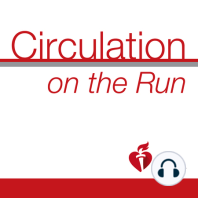16 min listen
Circulation November 13, 2018 Issue
ratings:
Length:
25 minutes
Released:
Nov 12, 2018
Format:
Podcast episode
Description
Dr Carolyn Lam: Welcome to Circulation on the Run, your weekly podcast summary and backstage pass to the journal and its editors. I'm Dr Carolyn Lam, Associate Editor from the National Heart Center and Duke National University of Singapore. This week's feature discussion focuses on first and man pilot study results of pericardiotomy and its influence on left ventricular diastolic reserve with volume loading. Very fascinating implications for heart failure with reserved ejection fraction, coming right up after these summaries. Cardiac dysfunction is a major component of sepsis-induced multi-organ failure in critical care units. But what are the underlying mechanisms and potential therapeutic approaches to this? Well, in today's paper from co-first authors Drs Sun and Yao, corresponding author Dr Chang, and colleagues from UT Southwestern Medical Center, the authors examine the status of cardiac autophagy and its role during sepsis pathogenesis using a rodent lipopolysaccharide-induced sepsis model. They've found that forced overexpression of Beclin-1 in the heart promoted autophagy and mitophagy, protected mitochondria, improved cardiac function, and alleviated inflammation and fibrosis after a lipopolysaccharide challenge. Whereas, haplosufficiency for Beclin-1 resulted in the opposite effects. For the more injection of a cell permeable Tat-Beclin-1 peptide improved outcomes in lipopolysaccharide-challenged animals. Thus promoting Beclin-1-dependent signaling may be a novel and effective intervention to alleviate organ dysfunction caused by maladaptive autophagy during severe sepsis. The next paper presents important experimental data that causes us to consider the potential cardiovascular hazards of anti B-cell activating factor immunotherapy, which is currently approved for the treatment of autoimmune systemic lupus erythematosus. You see, genomic data has shown that B-cell activating factor receptor pathway is specifically essential for the survival of conventional B lymphocytes, which is a key driver of coronary heart disease. However, in today's paper from co-first authors, Drs Tsiantoulas and Sage, corresponding author Dr Binder and colleagues from Medical University of Vienna, the authors reported an unexpected finding that B-cell activating factor neutralization increased atherosclerotic plaque size and complexity despite efficient depletion of mature, conventional B lymphocytes. Furthermore, the authors provided evidence suggesting a novel B-cell independent anti-inflammatory property of B-cell activating factor. They showed that the expression of the alternative B-cell activating factor binding receptor, transmembrane activator and CAML interactor in myeloid cells limited atherosclerosis thus showing novel atheroprotective pathways. Thus, these results introduce a new perspective with respect to the potential cardiovascular hazards that may be associated with the long term blockade of B-cell activating factor in chronic inflammatory settings. There is a need for more refine therapeutic approaches targeting the B-cell activating factor pathway. Vascular smooth muscle cells are known to possess remarkable plasticity undergoing fundamental phenotypic switches from a differentiated to a dedifferentiated state in response to vascular injury or remodeling. However, what are the underlying cellular processes by which vascular smooth muscle cells maintain their cell identity? Well, in today's paper from co-first authors Dr Yao, Yu and Li, corresponding Dr Wang from Fu Wai Hospital National Center for Cardiovascular Diseases, Chinese Academy of Medical Science and Peking University Medical College. The authors applied single cell RNA sequencing to analyze disease human arteries and identified histone variant H2A.Z as a
Released:
Nov 12, 2018
Format:
Podcast episode
Titles in the series (100)
Circulation August 30, 2016 Issue: Circulation Weekly: Your Weekly Summary & Backstage Pass To The Journal by Circulation on the Run
